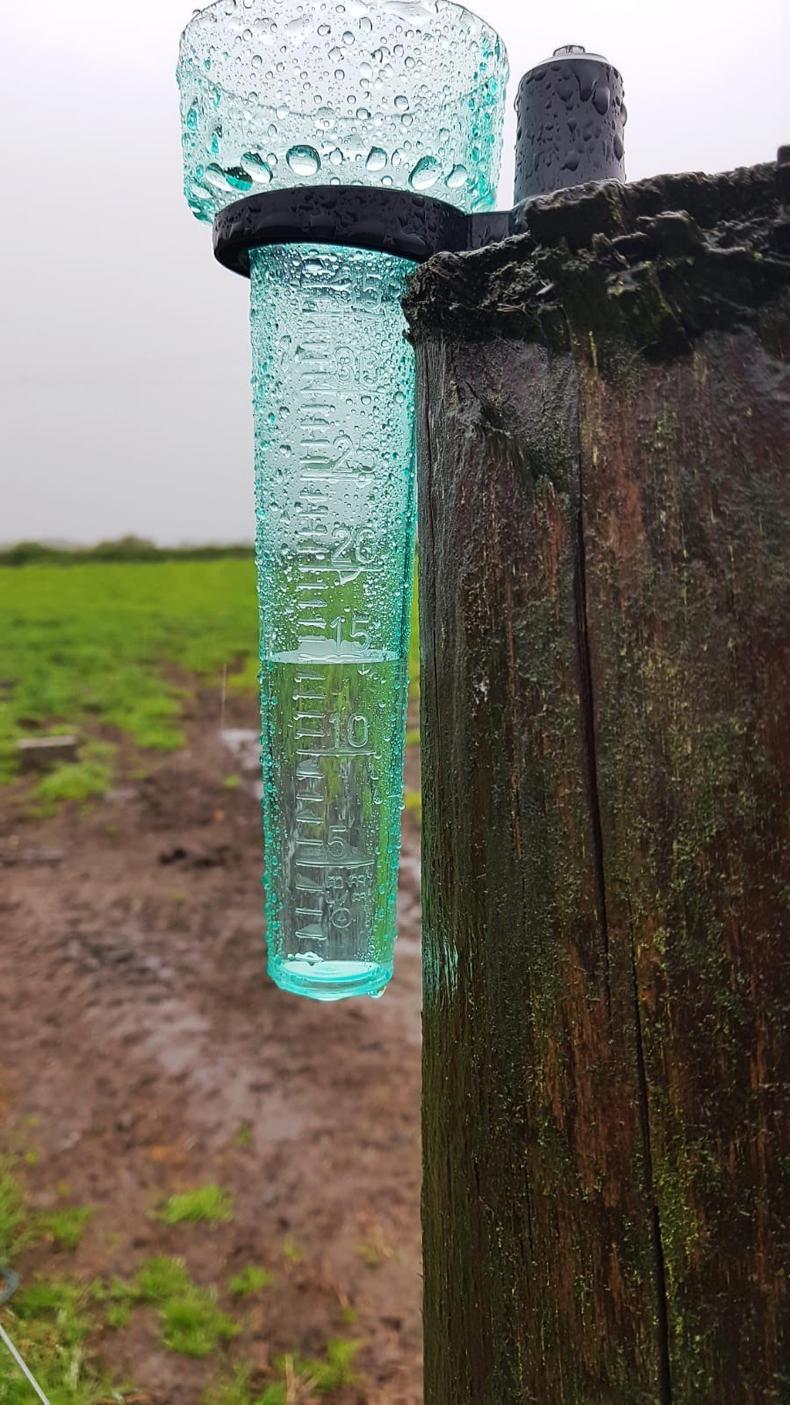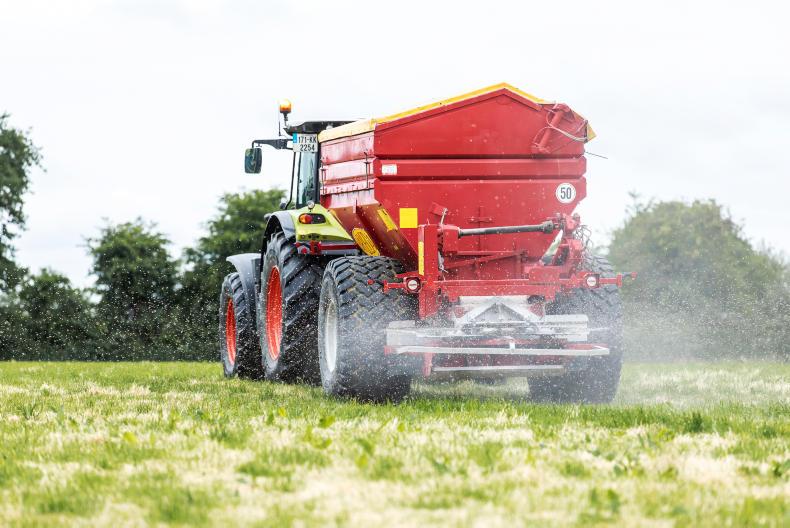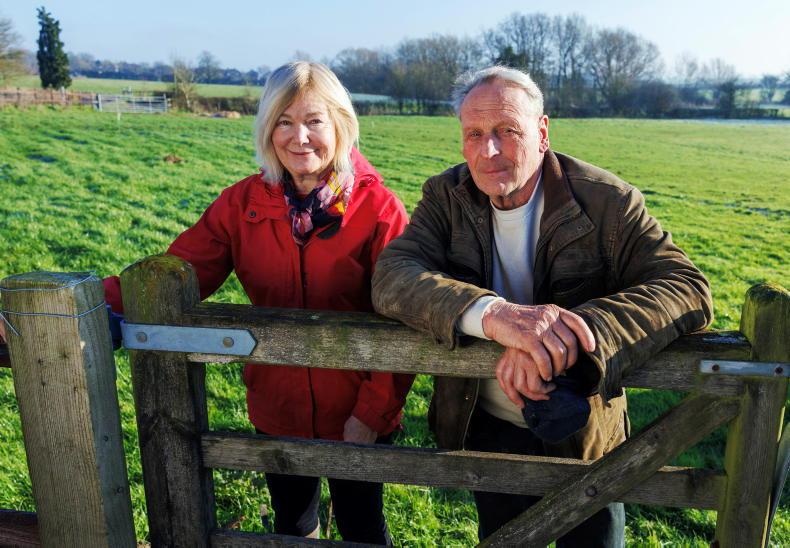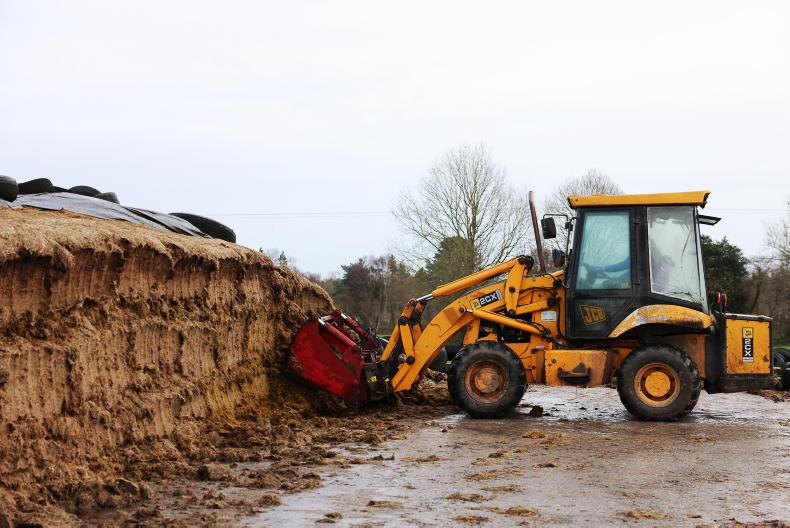Heavy rain last weekend and earlier this week gave relief to thousands of farmers. Fears of a prolonged drought have been abated, at least for now.
Unfortunately, not all farmers got to benefit from the rain and some of those who were in a drought will continue to be in a squeeze for grass until they get significant rainfall.
Significant rainfall is at least 25mm total over the space of a few days.
Many farmers have seen cows drop in milk yield over the last 10 days or so
Very heavy thunderstorms with flash floods are not ideal as a lot of the rain gets washed off as opposed to soaking into the soil.
It’s amazing how quickly sentiment shifts depending on grass supply.
When grass growth and average farm cover is falling, the focus moves from the quality of grass to the quantity of grass. But where grass is plentiful the focus shifts back to quality again. Quality grass is a scarce commodity at present.
Many farmers have seen cows drop in milk yield over the last 10 days or so.
Weeks of stress
The leaf-to-stem ratio in lots of paddocks is tipped in favour of stem due to weeks of stress brought about by soil moisture deficits, longer rotation lengths and grazing higher covers than normal.
Correcting the quality problem will be the challenge over the next few weeks. How to do it depends on what scenario your farm is in.
Scenario A: OK for grass, got enough rain
This is probably the position most farmers find themselves in. Grass growth was declining, extra meal was being fed and the rain just came at the right time to avoid the need to feed silage.
These farmers find themselves in a position where they now have adequate grass and decent growth rates but quality is poor.
The objective here is to reduce or remove supplement and to improve grass quality in order to increase milk yields and reduce costs.
The first step should be to identify and remove surplus grass early.
A burst in grass growth will be expected after the rain, so I don’t see any harm in deliberately setting a high demand for a few weeks by skipping over and baling paddocks that are strong or stemmy.
Normally, at this time of year, a comfortable demand would be around 60kg/day, which is a stocking rate of around 3.5 cows/ha when 1kg of meal is being fed per cow.
Considering growth rates should be higher for two to three weeks after the rain, I would be comfortable setting demand at 70kg/day (stocking rate of 4.1 cows/ha) for this time.
It won’t be possible to skip over and cut all paddocks
Before you can afford to skip over paddocks you need to make sure you have a true grass surplus. You must walk your farm to know this. If average farm cover is over 180kg/cow, then you can afford to skip over paddocks.
The important thing is not to set demand high for too long. If a decision is made to skip a paddock then cut and bale it as soon as possible.
Keep in mind also that if a significant proportion of the farm is cut, regrowths and average farm cover will be lower than normal.
It won’t be possible to skip over and cut all paddocks.
The other forms of mechanical correction include pre-mowing and topping. Grass quality in the subsequent sward will be better than if no topping or pre-mowing was carried out. However, there are some drawbacks.
Both methods will delay the recovery in growth rate after cutting so be careful not to do too much at once.
Topping after grazing runs the risk of cutting off some regrowth which will further slow recovery. Topping also means that the cut grass is left to decay.
Pre-mowing removes the cows’ ability to select leafy grass. While subsequent sward quality will be good, if there is a lot of stem in the pre-mowed sward then the cows will be grazing this, which will reduce their feed quality compared to if they grazed the standing sward. If topping, make sure the cutting height is between 3.5cm and 4cm.
Scenario B: Short of grass, got enough rain
Farmers in this scenario let their average farm cover run down before the rain came. Farmers in this category have very little grass with an average farm cover between 400kg/ha and 500kg/ha, which is very tight.
On the plus side, grass quality is generally good as rotation lengths were kept short and pre-grazing yields were never too high.

Most of the country got rain over the last seven days.
However, these farmers must go on a slow rotation length now in order to get average farm cover back to normal.
A very slow rotation length is 50 to 60 days and the only way this can be achieved is by putting in a lot of supplement in the form of meal and silage.
If growth rates are good (in the region of 70kg per day) and demand is low (30kg/day), then average farm cover should increase by almost 300kg/ha in a week which means they will be back to normal in a week.
The key thing is to monitor average farm cover and growth rates carefully so as not to feed for longer or shorter than is necessary
Typical feeding rates in this scenario are 6kg of grass, 6kg of meal and 6kg of silage. Depending on what works best for the particular farm, the silage and grass can be split into two 12-hour allocations, or fed all at once, eg if cows were housed or stood off in a feed pad at night.
The key thing is to monitor average farm cover and growth rates carefully so as not to feed for longer or shorter than is necessary.
Where average farm cover is less than 500kg/ha now, grass growth will be slower to recover than if average farm cover was above 500kg/ha.
Farmers in this position should console themselves with the fact that grass quality for the next rounds will be good and they shouldn’t have to do much if any mechanical correction.
Scenario C: Short of grass, not enough rain
These farmers are undoubtedly in the worst position of the lot. Unfortunately, most – if not all – of the thunderstorms have passed them by. In many cases, neighbouring parishes and farms have got loads of rain which adds to the frustration. All farmers in this position can do is to try to manage as best they can until rain does come.
In most cases, average farm cover is now less than 500kg/ha.
Try not to let it go below 400kg/ha by setting the demand at the growth rate.
The longer these farms go without rain the more severe the effects will be
So if the average farm cover is 450kg/ha and growth rate is 25kg/day, then the demand should be set at 25kg/day. If the stocking rate is three cows/ha, that means the most amount of grass that can be fed is a little over 8kg/day.
The rest of the diet will need to be made up in the form of meal and silage. Stick to a 25- to 30-day rotation length during this period but when sufficient rain does come move to a longer rotation length as per farmers in Scenario B.
The longer these farms go without rain the more severe the effects will be, both in terms of the effect on grass growth and profitability. At this stage, non-essential stock such as cattle or surplus heifers should be sold.
Cows that are marked for culling should be sold.
Depending on how long the drought is expected to last, cows could be scanned and any cows not scanned in-calf and served less than 21 days ago could be considered for sale as a cull cow.
Selling 10% of the herd increases the grass available to the rest of the herd by almost 2kg per day.
Mixed reaction to use of fertiliser
Farmer reaction to the use of protected urea before and during the recent dry spell has been mixed. Some farmers are saying that the fields that got protected urea were more stressed than those that got CAN-based nitrogen.
Of course, none of this feedback is particularly scientific and there are some farmers who haven’t noticed any difference but it’s just something to keep in mind.
There will be a natural mineralisation of nitrogen after the dry spell
Up to the end of May, there was no real difference in growth rates observed between protected urea and CAN in trials at Teagasc Moorepark. However, it will be interesting to see if there is a difference in growth at the next grazing due next week.
Farmers in Scenarios A and B should resume spreading fertiliser now. The quantities required for good grass growth will not be high.
There will be a natural mineralisation of nitrogen after the dry spell anyway. In most cases, 0.8 to 1 unit of nitrogen per day should be sufficient. Farmers in Scenario C should cease fertiliser until rain arrives.
Read more
Dairy management: what now after rain?
Grass+: most feeling the pinch this week
Heavy rain last weekend and earlier this week gave relief to thousands of farmers. Fears of a prolonged drought have been abated, at least for now.
Unfortunately, not all farmers got to benefit from the rain and some of those who were in a drought will continue to be in a squeeze for grass until they get significant rainfall.
Significant rainfall is at least 25mm total over the space of a few days.
Many farmers have seen cows drop in milk yield over the last 10 days or so
Very heavy thunderstorms with flash floods are not ideal as a lot of the rain gets washed off as opposed to soaking into the soil.
It’s amazing how quickly sentiment shifts depending on grass supply.
When grass growth and average farm cover is falling, the focus moves from the quality of grass to the quantity of grass. But where grass is plentiful the focus shifts back to quality again. Quality grass is a scarce commodity at present.
Many farmers have seen cows drop in milk yield over the last 10 days or so.
Weeks of stress
The leaf-to-stem ratio in lots of paddocks is tipped in favour of stem due to weeks of stress brought about by soil moisture deficits, longer rotation lengths and grazing higher covers than normal.
Correcting the quality problem will be the challenge over the next few weeks. How to do it depends on what scenario your farm is in.
Scenario A: OK for grass, got enough rain
This is probably the position most farmers find themselves in. Grass growth was declining, extra meal was being fed and the rain just came at the right time to avoid the need to feed silage.
These farmers find themselves in a position where they now have adequate grass and decent growth rates but quality is poor.
The objective here is to reduce or remove supplement and to improve grass quality in order to increase milk yields and reduce costs.
The first step should be to identify and remove surplus grass early.
A burst in grass growth will be expected after the rain, so I don’t see any harm in deliberately setting a high demand for a few weeks by skipping over and baling paddocks that are strong or stemmy.
Normally, at this time of year, a comfortable demand would be around 60kg/day, which is a stocking rate of around 3.5 cows/ha when 1kg of meal is being fed per cow.
Considering growth rates should be higher for two to three weeks after the rain, I would be comfortable setting demand at 70kg/day (stocking rate of 4.1 cows/ha) for this time.
It won’t be possible to skip over and cut all paddocks
Before you can afford to skip over paddocks you need to make sure you have a true grass surplus. You must walk your farm to know this. If average farm cover is over 180kg/cow, then you can afford to skip over paddocks.
The important thing is not to set demand high for too long. If a decision is made to skip a paddock then cut and bale it as soon as possible.
Keep in mind also that if a significant proportion of the farm is cut, regrowths and average farm cover will be lower than normal.
It won’t be possible to skip over and cut all paddocks.
The other forms of mechanical correction include pre-mowing and topping. Grass quality in the subsequent sward will be better than if no topping or pre-mowing was carried out. However, there are some drawbacks.
Both methods will delay the recovery in growth rate after cutting so be careful not to do too much at once.
Topping after grazing runs the risk of cutting off some regrowth which will further slow recovery. Topping also means that the cut grass is left to decay.
Pre-mowing removes the cows’ ability to select leafy grass. While subsequent sward quality will be good, if there is a lot of stem in the pre-mowed sward then the cows will be grazing this, which will reduce their feed quality compared to if they grazed the standing sward. If topping, make sure the cutting height is between 3.5cm and 4cm.
Scenario B: Short of grass, got enough rain
Farmers in this scenario let their average farm cover run down before the rain came. Farmers in this category have very little grass with an average farm cover between 400kg/ha and 500kg/ha, which is very tight.
On the plus side, grass quality is generally good as rotation lengths were kept short and pre-grazing yields were never too high.

Most of the country got rain over the last seven days.
However, these farmers must go on a slow rotation length now in order to get average farm cover back to normal.
A very slow rotation length is 50 to 60 days and the only way this can be achieved is by putting in a lot of supplement in the form of meal and silage.
If growth rates are good (in the region of 70kg per day) and demand is low (30kg/day), then average farm cover should increase by almost 300kg/ha in a week which means they will be back to normal in a week.
The key thing is to monitor average farm cover and growth rates carefully so as not to feed for longer or shorter than is necessary
Typical feeding rates in this scenario are 6kg of grass, 6kg of meal and 6kg of silage. Depending on what works best for the particular farm, the silage and grass can be split into two 12-hour allocations, or fed all at once, eg if cows were housed or stood off in a feed pad at night.
The key thing is to monitor average farm cover and growth rates carefully so as not to feed for longer or shorter than is necessary.
Where average farm cover is less than 500kg/ha now, grass growth will be slower to recover than if average farm cover was above 500kg/ha.
Farmers in this position should console themselves with the fact that grass quality for the next rounds will be good and they shouldn’t have to do much if any mechanical correction.
Scenario C: Short of grass, not enough rain
These farmers are undoubtedly in the worst position of the lot. Unfortunately, most – if not all – of the thunderstorms have passed them by. In many cases, neighbouring parishes and farms have got loads of rain which adds to the frustration. All farmers in this position can do is to try to manage as best they can until rain does come.
In most cases, average farm cover is now less than 500kg/ha.
Try not to let it go below 400kg/ha by setting the demand at the growth rate.
The longer these farms go without rain the more severe the effects will be
So if the average farm cover is 450kg/ha and growth rate is 25kg/day, then the demand should be set at 25kg/day. If the stocking rate is three cows/ha, that means the most amount of grass that can be fed is a little over 8kg/day.
The rest of the diet will need to be made up in the form of meal and silage. Stick to a 25- to 30-day rotation length during this period but when sufficient rain does come move to a longer rotation length as per farmers in Scenario B.
The longer these farms go without rain the more severe the effects will be, both in terms of the effect on grass growth and profitability. At this stage, non-essential stock such as cattle or surplus heifers should be sold.
Cows that are marked for culling should be sold.
Depending on how long the drought is expected to last, cows could be scanned and any cows not scanned in-calf and served less than 21 days ago could be considered for sale as a cull cow.
Selling 10% of the herd increases the grass available to the rest of the herd by almost 2kg per day.
Mixed reaction to use of fertiliser
Farmer reaction to the use of protected urea before and during the recent dry spell has been mixed. Some farmers are saying that the fields that got protected urea were more stressed than those that got CAN-based nitrogen.
Of course, none of this feedback is particularly scientific and there are some farmers who haven’t noticed any difference but it’s just something to keep in mind.
There will be a natural mineralisation of nitrogen after the dry spell
Up to the end of May, there was no real difference in growth rates observed between protected urea and CAN in trials at Teagasc Moorepark. However, it will be interesting to see if there is a difference in growth at the next grazing due next week.
Farmers in Scenarios A and B should resume spreading fertiliser now. The quantities required for good grass growth will not be high.
There will be a natural mineralisation of nitrogen after the dry spell anyway. In most cases, 0.8 to 1 unit of nitrogen per day should be sufficient. Farmers in Scenario C should cease fertiliser until rain arrives.
Read more
Dairy management: what now after rain?
Grass+: most feeling the pinch this week











SHARING OPTIONS